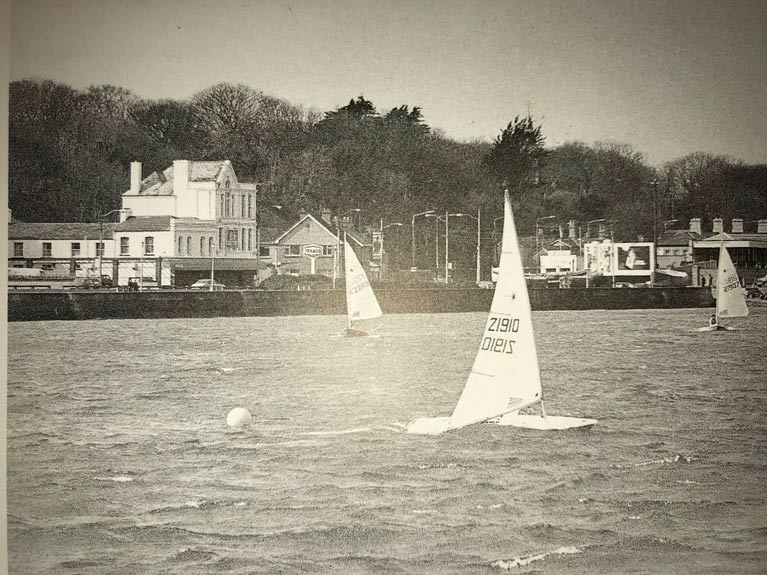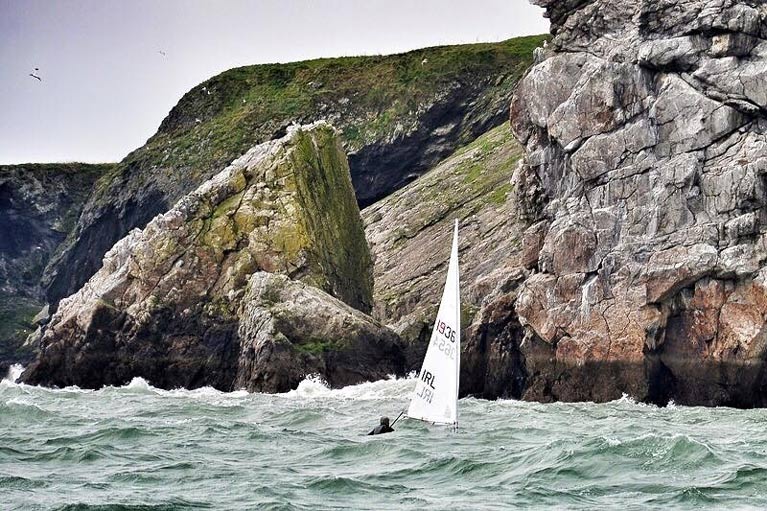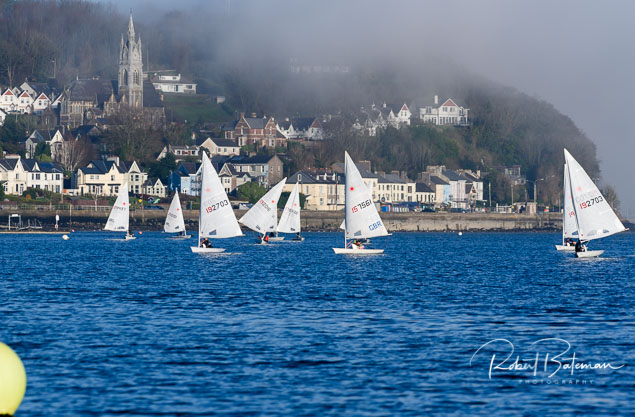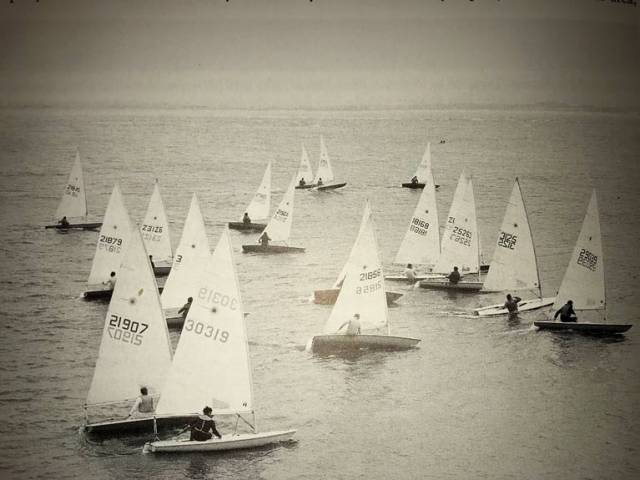While most sailors pack up their boats in October and look forward to a cosy and relaxed winter, there are a few hardy sailors who actually look forward to the Winter months writes Dave Quinn. The Laser dinghy was unveiled in 1971 at the New York Boat Show. Frostbite sailing has been a fixture on many club calendars since the mid-’70s, with fleets mostly comprising Lasers in venues other than Dun Laoghaire. Recent years have seen an impressive increase in numbers around the country and this success should attract the attention of those trying to grow the sport. From my perspective, the appeal of Frostbite sailing is the convenience. Given the time of year, racing tends to be around short courses, with quick turnarounds, convenient start times and a focus on fun. We have compiled some reports from around to country to give some background to Frostbite sailing in the various centres, and an insight into the current success of the winter sailing scene.
Dublin Laser Sailing
In Dublin, there are two main winter sailing centres, Howth and Dun Laoghaire. The Howth Winter ‘Frostbite’ Series, which is the oldest in Ireland, has been running since the Autumn of 1974. John Gore-Grimes first identified that the Laser, with its sturdy design, easy transport options and low maintenance offered a unique opportunity for Howth sailors to race regularly through the winter. The first races were held that Autumn and this marked the start of year-round sailing in Howth Yacht Club. Vincent Wallace won the first two series, with the familiar names of Anthony Gore-Grimes, Robert Michael, Neville Maguire and David Dickson all featuring.
 Early photo of Laser racing from inside Howth Harbour
Early photo of Laser racing from inside Howth Harbour
Racing was originally held in the harbour, similar to Dun Laoghaire now, but once the new harbour development was completed, racing moved outside to the channel between Howth and Irelands Eye. Such was the popularity of the years' Frostbite series that Laser International declared it the biggest Laser Club series in Europe. Since those early years there has always been a large winter series fleet in Howth, which has attracted some of the top laser sailors of the day Once the series moved outside the harbour, racing was mostly held off a fixed start line from the starters hut at the end of the west pier (which can still be seen today next to Aqua restaurant). This often led to reaching starts, and huge amounts of fun. I distinctly remember a certain Gavan Jones approaching the line from above, calling Starboard on the entire fleet, reaching towards the line on port! In more recent years, the format was improved with a dedicated committee boat, 2 races a day and high-quality courses. The series ends each year with the unique ‘Round the Island’ race. This is a single lap race, around the Island, with a twist. Sailors can go either way round. Tides, Winds, Eddies and Wave patterns all dominate sailors minds in the week running up to the big race. One side always wins out, although its not always that obvious. This is one of the most prestigious and sought after trophies in Howth Yacht Club. Simon Knowles currently holds the record for the most number of wins, at 4.
 Laser racing Round Ireland’s eye in the annual Round the Island race
Laser racing Round Ireland’s eye in the annual Round the Island race
The now 49-year-old DMYC Frostbite series (next year is the big Five-O) has seen a monumental increase in Laser entries this season in Dun Laoghaire Harbour. The first series kicked off on Nov 04th with a whopping 61 lasers entered across the 3 rigs. This marks a 154% increase on the 2017/2018 season. Such was the volume of entries, the DMYC organisers and laser representatives agreed that it would be wise to merge the standard and 4.7 rigs and give the radials their own start. What has been most encouraging to see has been the number of youth sailors taking part in the series. This came about as a result of ongoing dialogue between the Laser reps, parents and youth coaches where it was highlighted to them that the quality of racing and organisation on the water was worth their investment as it would give them plenty of starting and race management practice, not only amongst their peers but amongst some of slightly ‘saltier’ dog’s too! The genuine willingness of the DMYC frostbite organisers to accommodate the laser class has also been a major factor in the success of the series to date. Special thanks must go to Neil Colin and his team. They have not only facilitated our wishes to provide both windward/leeward courses but triangular too. This has been lapped up by the competitors as it has enabled them to get much-needed race course practice in the winter, keeping them sharp and fit. The more ‘mature’ sailors have been surprised by the push for the line by their younger competitors with 2 minutes to go, making the starts a somewhat nerve-wracking experience for some! As you can gather, the laser fleet is alive and well in Dun Laoghaire and is super excited about the prospects the future holds!
Belfast Laser Sailing
In late 1974, Ron Hutchieson brought the first Laser to Ballyholme. In conjunction with Trevor Millar and a few others, by 1976, permission had been granted for racing at Ballyholme during the closed season with a short winter break in January. Initially, a practical break allowing for maintenance and recovery of tired rescue drivers (and presumably sailors). It now serves as a convenient time for half of the fleet to go skiing!
In 1977, a small drinks Ice Pick from Harrods was purchased and mounted as the overall prize. The “Icebreaker,” was born. In the following years, the Icebreaker grew both with racing for lasers, but also GP14s, and Enterprises. In the mid-1980s twenty to twenty-five lasers were regularly seen racing, with stalwarts past and present of the class and indeed Northern Irish and Irish sailing being amongst the fleet. At this time Gareth Flannigan often took home the trophy, but Chris Boyd, Charlie Taylor, Bill O’Hara, Brian Spence, Elaine Taylor and the late Denis Finlay were regular competitors.
In the 1990s and 2000s, Laser sailing boomed at Ballyholme, with many top sailors coming through the Icebreaker as we know it today. In the early 2000s when I joined the fleet, the front of a Sunday Icebreaker often resembled the front of the regional qualifiers with the McGovern brothers, James Espey, Bill O’Hara, Gareth Flannigan, Chris Boyd and Peter Kennedy sharing the spoils locally as well as more than a few regional and national championships.
More recently, the resurgence of the class in Ireland as a whole and the efforts of the committee to bring more Masters back to sailing the Icebreaker is going strong. Locally in Ballyholme, the efforts of Garth Maxwell to support and encourage those returning seem to know no bounds. At times upwards of forty boats, but usually nearly thirty race each week. Tough competition is seen in gold, silver, bronze and radial fleets with many old names returning to the fray. The ever-shrewd Chris Boyd remains more often than not at the front of the fleet, as any Masters who raced in Dun Laoghaire last year will be aware. John Simms, and his son Conor spar with each other weekly, and this year has seen the return of Matthew and Russell McGovern to racing alongside the occasional appearance from multiple former national champions. Further down the fleet, the racing is if anything tougher and more vicious as bragging rights are often so much more valuable than series results. The Ballyholme Icebreaker is in rude health and seems fit to continue its increase in standard and numbers taking part.
Cork Laser Sailing
Down in Cork, the laser fleet has thrived for many years. Since the mid-1970s, the fleet has grown into what it is today.
The Cork Laser fleet has proved to not be exclusive, with events held all year round that are tailored to suit each individual sailor. As a result, the number of laser sailors on the water over the past few years has been high.
The most popular events are usually the annual frostbite leagues, hosted by several Cork-based clubs. These include Kinsale, Monkstown and Royal Cork, to select a few. These leagues can attract all kinds of competition from a parent looking for a break, to the local club hotshot.
 Cork Harbour Laser Racing at Monkstown Bay Photo: Bob Bateman
Cork Harbour Laser Racing at Monkstown Bay Photo: Bob Bateman
Cork has an ever-expanding mix of Master and Youth sailors. Ever since the smaller sail plans were introduced, youth sailors in Cork have increased in number over the years. In conjunction with the rise in youth sailors, more experienced Master sailors have been dusting off their lasers and taking to the water.
The “youth” sailors tend to be very competitive about their racing. The Master laser sailors are very competitive in their own right, but prefer a friendly environment adopting a “Life is too short” attitude. This created a slight divide in the fleet, which then led to the organisation of a Laser frostbite series hosted by Monkstown Bay sailing club. Only standard rigs could compete at the time. This event suits the Master laser sailor, with short amounts of time on the water and fun racing. The youth sailors annually converge in October for the Royal Cork frostbites, where they compete for top spot in heated competition.
Every year the Cork Laser fleet continues to grow in size, including recreational sailors, Masters and youths.
Wexford Laser Sailing
Wexford is another well-established centre for Winter Laser sailing. They have been running a winter series since the late 1980s with 20 to 30 boats out on average. They also follow a common theme to the other series with racing on Sunday mornings at 11, and the series running from November to the end of April. They welcome visitors from as far as Blessington, Courtown, Dunmore East and Wicklow.
Overall it appears that winter club dinghy sailing continues to be a very important and successful aspect of our sport, covering a 6 month period where there is very little other activity in many centres. The short races, convenient start and finish times and low cost offer some valuable lessons to our sailing administrators and clubs at a time when we are trying to retain and grow our younger membership numbers.
The author wishes to acknowledge the assistance of Colin Leonard and Ron Hutchieson (Ballyholme), Chris Bateman (Cork), Gavan Murphy (Dun Laoghaire), Ronan Wallace/Paul Ebrill and James Sinnott (Wexford) in the compilation of this article.































































